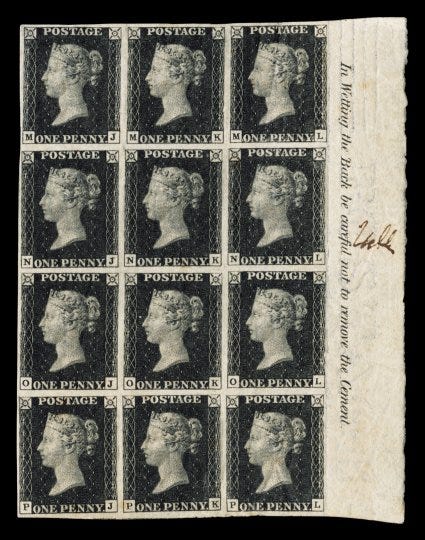Your questions, answered
Dear Matthew: tell us about the gum
Perhaps my favorite part of writing a Substack newsletter, rather than dead-trees articles, is the quick and ample feedback from readers. Yesterday I received a query from someone who is near and dear to me:
Hi Matthew,
I'm very much enjoying my new subscription to Stampazine. At some point, if you think appropriate, I would like to see a discussion of the subject of adhesives. I am curious as to how some of these stamps, particularly the large non-postal issues were affixed in earlier times.
—UB
Well, that’s both an easy question and a hard one.
Easy because gum, in more or less the same form we knew it until recently, was actually a feature of postage stamps from the very start. Rowland Hill, the English reformer who persuaded Parliament to enact a flat-rate, pre-paid domestic postage scheme in Britain in 1840, designed the first stamps with a wash of gum (he called it “cement”) on the back, enabling users to lick-and-stick from the get-go.

The world’s first stamp, the Penny Black, had instructions for users on the edge of each sheet: “In Wetting the Back be careful not to remove the Cement.”
This inscription would remain on the edge of British stamp sheets for decades. The gum consisted of a glutinous wash of potato starch, applied by brush at the printers, Perkins Bacon & Co. The Stanley Gibbons catalog notes that it was “variable in colour, efficiency and taste.” Its formula was tweaked over time, according to Gibbons: “After 1855, some gelatine was added and in 1864 double-gumming was adopted. Gum was always applied after the sheets were printed, but before perforation.”
As the use of postage stamps spread worldwide, their basic composition, including the application of gum to the back, was generally the same. Traditional stamp gum is readily water-soluble, which made removing stamps from letters by briefly soaking or steaming them a simple operation.
There are only a very few instances of countries issuing stamps ungummed for general use. Afghanistan is one example: all its stamps until 1907 were issued without gum. On a few occasions, such as during wartime or in other adverse conditions, other countries did likewise.
The special reprints of earlier issues produced by the United States Post Office Department in 1875 were issued without gum, as they were for sale to collectors and not intended to be postally used, though a few were. These scarce reprints (mostly distinguished by being on harder, whiter paper than the originals) are catalogued and collected without gum, sometimes noted as “NGAI”—no gum as issued.
In some cases, the gum applied to early stamps was of such poor quality that it proved detrimental to the stamps over time, affecting their paper and ink, and collectors have generally removed it by soaking to prevent deterioration. Confederate States issues are notorious for this, along with some early German States issues.
Revenue stamps typically also had gum, though one occasionally finds very early examples that have clearly been applied with mucilage or some other kind of glue, brushed onto the taxable document and visible outside of where the stamp is stuck.
Some stamps that were not intended for application to paper documents, or were used in hot climates where pre-gumming could present obvious difficulties, were likely also gummed by the user.
Tomorrow’s auction by Status International includes some beer-tax stamps of New South Wales that, although the references don’t say so, might have been gummed or might have been in the ungummed category. The stamps were meant to be stuck directly onto casks of beer and destroyed when the keg was tapped, so most of the surviving examples are unused or from archives.
Cheers! If any other reader has special knowledge about the gumming of revenue stamps, or has a question about some other aspect of philately, I’d love to hear from you.
‘Til tomorrow,



